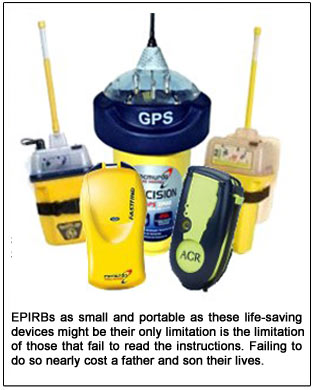EPIRB: a sure life-saving signal from outer space—maybe?
by Tom Rau
EPIRB, a sure life-saving signal from outer space, is a terrestrial acronym for emergency position indicator radio
beacon. In short, it’s an electronic distress signal beamed from a small device
aboard a boat or ship to search and rescue satellite receivers.
Maybe.
The maybe involves not the celestial complex component, but rather a simple terrestrial subcomponent: human
error. Such an error nearly cost a father
and son their lives in a recent boating mishap off the Florida coast.
According to Chris Landry, Senior Reporter for Soundings Magazine, the father bought a new EPIRB for their 25-
foot center console powerboat for an upcoming trip to the Bahamas. While underway their boat flooded and then
rolled. The EPIRB failed to activate.

The father and son clung to the over turned hull hopeful that they would be rescued. After eight hours, there was no rescue response—nothing. Apparently, they had failed to read the EPIRB
instructions. What the father and son didn’t know is that the EPIRB must be on the surface for its antenna to transmit GPS coordinates to SAR satellites.
Trapped within its pouch in the underside of the boat’s t-top, the EPIRB just as well have not been aboard. By happenstance, or if you wish by divine providence, the EPIRB worked free of
the pouch and floated to the surface, releasing its life-saving signal that led to
their rescue.
Since 1982, this incredible modern day satellite rescue system has saved over 24,500 people world-wide, and over 6,108 people in the U.S. NOAA, which plays a key role in the search and rescue satellite system, offers the following advice to mariners about
EPIRBs.
Listen up: these NOAA folks speak in a deck-plate language this old senior chief can clearly understand. As with any safety gear, it’s only as good as the person operating it. Spend some time familiarizing yourself with your EPIRB. The following addresses
the 406 MHz EPIRB designed for maritime
use. Test your EPIRB in accordance with manufacturers’ recommendations. Most EPIRB activation switches have a
test position.
This allows the entire unit, including battery and antenna, to be tested without generating a false alarm. Register your EPIRB with NOAA. This will help flush out a false alarm. If the EPIRB is properly registered, the situation
can be resolved with a simple phone call from the Coast Guard. It will also help speed a rescue if need be. If your EPIRB is not registered, a form is included on NOAA’s homepage. It’s free, it’s easy, and it’s the law. Affix your registration decal on the EPIRB so it can be easily read without taking the EPIRB out of its bracket.
A surprising amount of false alarms are generated by people—sometimes Coast Guard safety inspectors—doing so to
check the decal. Never remove the EPIRB from its bracket without first switching it to the “Off” position, unless it is an actual distress. Also, never allow others to remove it. Many false alarms are generated by
curious meddlers.
Another common source of false alarms: removing the EPIRB to perform boat maintenance such as painting.
Ensure that the EPIRB batteries are within their expiration date. If the EPIRB is not on the vessel, it should be switched off. This avoids the embarrassment of SAR forces converging on the trunk of your car, hopefully not during rush hour.
Finally, search and rescue satellites are good at what they do, detecting emergency beacons. An activation of a 406 MHz EPIRB for just a few seconds will be detected. After a few minutes, it will be detected and located. This is good if you’re in distress, but if you’re not, you just generated a false alarm and a possible needless use of valuable lifesaving resources that might be desperately
needed elsewhere.
It could be you elsewhere, Boat Smart; know your EPIRB. For more information regarding EPIRBs and how
to registered then log onto:
http://www.sarsat.noaa.gov
Tom Rau is a retired 27-year Coast
Guard veteran, boating safety columnist,
and author of Boat Smart Chronicles,
Lake Michigan Devours Its Wounded.
His book is a 20-year journal of recreational
boating mishaps with valuable
lessons learned. It, along with recent
rescue stories, can be viewed at:
www.boatsmart.net
TOP
|